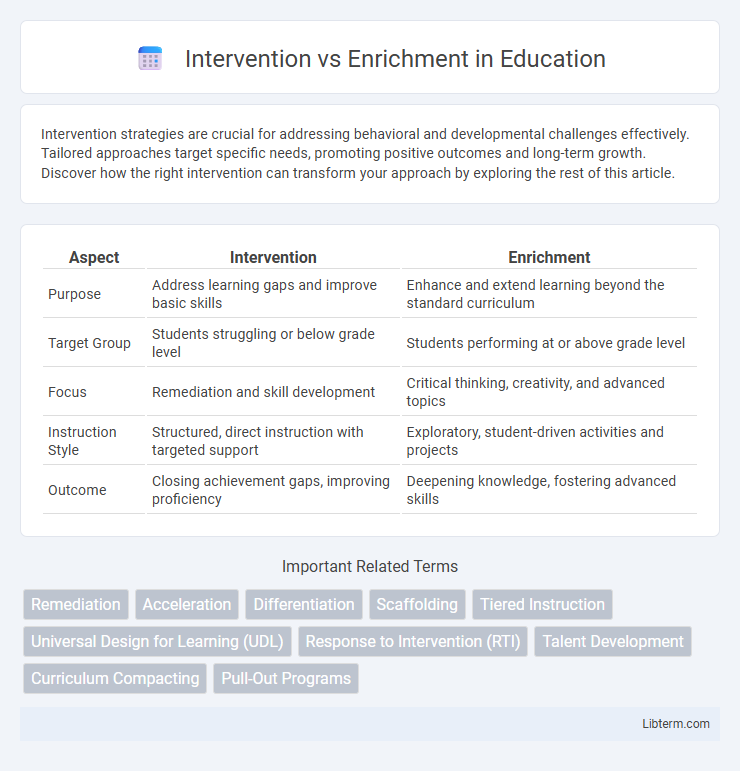Intervention strategies are crucial for addressing behavioral and developmental challenges effectively. Tailored approaches target specific needs, promoting positive outcomes and long-term growth. Discover how the right intervention can transform your approach by exploring the rest of this article.
Table of Comparison
| Aspect | Intervention | Enrichment |
|---|---|---|
| Purpose | Address learning gaps and improve basic skills | Enhance and extend learning beyond the standard curriculum |
| Target Group | Students struggling or below grade level | Students performing at or above grade level |
| Focus | Remediation and skill development | Critical thinking, creativity, and advanced topics |
| Instruction Style | Structured, direct instruction with targeted support | Exploratory, student-driven activities and projects |
| Outcome | Closing achievement gaps, improving proficiency | Deepening knowledge, fostering advanced skills |
Understanding Intervention and Enrichment
Intervention is a targeted instructional approach designed to address specific learning gaps or difficulties, often implemented when students struggle to meet grade-level standards. Enrichment provides advanced learning opportunities that deepen understanding and challenge students beyond the standard curriculum, fostering critical thinking and creativity. Both strategies support differentiated learning, but intervention focuses on remediation, while enrichment emphasizes extension and enhancement.
Key Differences Between Intervention and Enrichment
Intervention targets students struggling to meet grade-level standards by providing specialized, remedial support aimed at closing learning gaps, whereas enrichment offers advanced, challenging activities to extend knowledge beyond the standard curriculum. Intervention often involves structured, small-group instruction based on diagnostic assessments, while enrichment encourages independent or collaborative exploration to deepen understanding and critical thinking skills. Key differences include their objectives--remediation versus advancement--and their implementation settings within educational programs.
Defining Educational Intervention
Educational intervention refers to targeted strategies and programs designed to address specific learning gaps or challenges faced by students, aiming to improve their academic performance. It involves systematic assessment, individualized support, and evidence-based instructional methods to help students overcome difficulties and achieve grade-level proficiency. Unlike enrichment, intervention prioritizes remediating deficits rather than enhancing existing skills.
The Goals of Enrichment Activities
Enrichment activities aim to extend learning by fostering critical thinking, creativity, and problem-solving skills beyond standard curriculum requirements. These activities encourage student engagement through exploration of advanced topics, promoting intrinsic motivation and deeper understanding. Enrichment supports individual strengths and interests, preparing learners for complex real-world challenges and lifelong learning.
Situations Requiring Intervention
Situations requiring intervention typically involve students struggling to meet grade-level standards or exhibiting significant learning gaps that hinder academic progress. Intervention strategies are targeted and intensive, aiming to provide remedial support through personalized instruction, progress monitoring, and specialized resources. Unlike enrichment, which enhances learning for proficient students, intervention addresses urgent educational needs to close achievement gaps effectively.
When to Choose Enrichment Over Intervention
Enrichment should be chosen over intervention when a student demonstrates proficiency in core skills but requires challenges that extend beyond the standard curriculum to foster critical thinking and creativity. It is ideal for learners who are not struggling but benefit from advanced materials or activities that enhance their knowledge and engagement. Enrichment strategies promote deeper understanding and motivation without addressing learning deficits typically targeted by interventions.
Strategies for Effective Interventions
Effective intervention strategies focus on targeted support tailored to individual student needs, utilizing data-driven assessments to identify specific learning gaps. Differentiated instruction, small group sessions, and progress monitoring ensure that interventions address skill deficits promptly and effectively. Integrating evidence-based practices such as scaffolding, explicit teaching, and frequent feedback enhances student engagement and accelerates learning outcomes.
Designing Successful Enrichment Programs
Designing successful enrichment programs requires a deep understanding of students' individual strengths and interests to foster advanced skills beyond the standard curriculum. Effective enrichment incorporates differentiated instruction, project-based learning, and opportunities for creative problem-solving to stimulate intellectual growth and motivation. A data-driven approach improves program outcomes by continuously assessing student engagement and adjusting challenges to maintain optimal development.
Measuring Outcomes: Intervention vs. Enrichment
Measuring outcomes in intervention focuses on quantifiable improvements in specific skills or behaviors, often using standardized assessments to track progress against set benchmarks. Enrichment outcomes emphasize broader cognitive and social development, assessed through qualitative observations and feedback on increased engagement, creativity, and critical thinking. Effective evaluation combines both approaches to capture comprehensive learner growth.
Integrating Intervention and Enrichment in the Classroom
Integrating intervention and enrichment in the classroom creates a balanced approach that supports diverse learner needs by providing targeted skill remediation alongside opportunities for advanced exploration. Effective strategies include differentiated instruction, flexible grouping, and personalized learning plans, which enable educators to address skill gaps while promoting critical thinking and creativity. Data-driven assessments inform the timing and intensity of interventions and enrichment activities, ensuring optimal academic growth for all students.
Intervention Infographic

 libterm.com
libterm.com